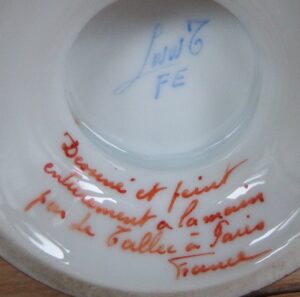An excellent starting point for those interested in Le Tallec decorated Limoges porcelain is the following publication:
 Atelier Le Tallec Hand Painted Limoges Porcelain: For Connoisseurs, Royalty, and Tiffany & Co.
Atelier Le Tallec Hand Painted Limoges Porcelain: For Connoisseurs, Royalty, and Tiffany & Co.
The hand painted Limoges porcelain from the Paris decorating studio Atelier Le Tallec, dating from 1930 through 2002, are displayed in over 490 vivid color photographs. Limoges bells, boxes, candlesticks, and vases to dinnerware, apothecary jars, ginger jars, chocolate pots, and tea sets are shown in a variety of patterns, including chinoiseries, figurals, florals, foliage, fauna of land, sea, and air, insects, geometric forms, and abstracts. Engaging text provides a brief history of Atelier Le Tallec and it’s artists, examines the studio’s marks, and organizes the patterns by their styles. A bibliography, index, and current (2002) market values are included. This book will charm everyone with an eye for beauty.
Keith and Thomas Waterbrook-Clyde have been collecting Atelier Le Tallec hand painted Limoges porcelain for years. They have authored several well-regarded books on Limoges porcelain, published by Schiffer Publishing, Ltd.
ISBN: 9780764317088
ISBN-10: 0764317083
Publisher: Schiffer Publishing
Publication Date: December 16th, 2002
Pages: 240
Language: English
Series: Schiffer Book for Collectors
Le Tallec Date Marks
Each piece decorated by Atelier Le Tallec in Paris is signed by a scripted LT motif in a Sèvres-like style. Inside the LT motif there are two sets of letters, a letter code in the upper part indicating the date of production, and second the initials of the painter in the lower part. This dating system was adopted from 1941. Le Tallec’s pieces without these marks are therefore likely to be produced between 1930 and 1941. Incrementation of the dating system was done at six-month intervals from 1941 to 1991, then every year since. During the period from 1967 to 1968 lower case letters from the Greek alphabet were used. From 1978, the date of the transfer of the atelier from Belleville to rue de Reuilly in Paris, the date mark starts by R (for Reuilly), followed by the letter. From 1995, following a move to the avenue Daumesnil in Paris, the date mark starts by D (for Daumesnil) followed by the letter.

Example
The image below shows typical markings, the sentence dessiné et peint entièrement à la main par Le Tallec à Paris France is also drawn in iron red pigment. In this case the date mark “WW” tells us the piece was produced in 1965. The painter’s initials were “FE”.

French porcelain
 Invented in China during the 7th or 8th century, it was not until the very early 18th century that the secret of true ‘hard paste’ porcelain was discovered in Germany. Prior to that point, imported Chinese porcelain was a desired and expensive luxury in Europe. In France many experiments had led to the manufacture of soft paste porcelain by the leading manufacturers, often under royal/aristocratic patronage. By the mid 18th century kaolin was discovered near Limoges, and this was the beginning of the French true porcelain manufacturing. The Sèvres royal manufacture took the lead in European porcelain design, constantly developing it’s aesthetic with new forms and decorations. Limoges also became a major centre for porcelain manufacture in France, with up to 30 factories in the 19th century. The excellence of French porcelain is today recognized worldwide. In Sèvres, the manufacture still produces porcelain, respecting traditional techniques and materials. In Limoges, a dozen of centuries-old factories operate like Bernardaud, Haviland, Deshoulières and Royal Limoges. There are also many independent time-served ceramicists all over France, mastering traditional porcelain decoration techniques. In a delicate balance between tradition and innovation, they continue to transmit their knowledge.
Invented in China during the 7th or 8th century, it was not until the very early 18th century that the secret of true ‘hard paste’ porcelain was discovered in Germany. Prior to that point, imported Chinese porcelain was a desired and expensive luxury in Europe. In France many experiments had led to the manufacture of soft paste porcelain by the leading manufacturers, often under royal/aristocratic patronage. By the mid 18th century kaolin was discovered near Limoges, and this was the beginning of the French true porcelain manufacturing. The Sèvres royal manufacture took the lead in European porcelain design, constantly developing it’s aesthetic with new forms and decorations. Limoges also became a major centre for porcelain manufacture in France, with up to 30 factories in the 19th century. The excellence of French porcelain is today recognized worldwide. In Sèvres, the manufacture still produces porcelain, respecting traditional techniques and materials. In Limoges, a dozen of centuries-old factories operate like Bernardaud, Haviland, Deshoulières and Royal Limoges. There are also many independent time-served ceramicists all over France, mastering traditional porcelain decoration techniques. In a delicate balance between tradition and innovation, they continue to transmit their knowledge.
Le Tallec insists on every design, every part of a design and even its minutest line, being drawn by hand only. No mechanical process is ever used. In practice, this means that, for example, a medium size vase represents 15 hours of hand work.
![]()
